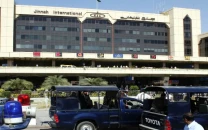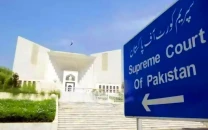The poison in our pipes
It seems that the government feels that there are bigger issues to focus on than upgrading the water supply network.

The writer is a sub editor at The Express Tribune and tweets @aimamk
Here we must note that water being supplied at home will still be contaminated; people can go to a filtration plant in their locality, fill up a bottle of water to drink and then go home. This is how our government plans to supply safe drinking water to the common man. Of course, those living in Gulberg, Defence, Model Town and other fancier parts of the city can buy their safe drinking water from the nearest grocery store where they will have the option of choosing between several mineral water brands. Those who are even more cautious will buy bottled water that has international labeling on it.
Currently, the Lahore High Court is hearing a petition against the Water and Sanitation Agency (WASA) for provision of safe drinking water. Going through the progress of the case can make for interesting reading. Late last year, the petitioner said his water woes had been fixed and sought withdrawal of his petition. Previously, he had insisted that access to safe drinking water was a matter of public interest and his petition must be taken seriously. So when he asked to withdraw his case, the judge admonished him, saying that he could be tried for “wasting the court’s time”. He refused to dismiss the petition and WASA was told to submit a report on the findings of the tests by the Pakistan Council of Scientific and Industrial Research laboratory on samples of drinking water taken from various parts of the city.
This is not the first time WASA is in trouble over the quality of drinking water in the city. In 2009, it was taken to court about dangerous levels of arsenic found in Lahore’s water and a report was produced that said the Pakistan Council of Research in Water Resources (PCRWR) tested water samples from 457 tube wells and found 183 of them contaminated. It said 74 water samples were found having arsenic value beyond the permissible limit of 50ppb (Pakistani standard), while the remaining 109 samples were declared to be within the acceptable limit. In June 2010, another analysis found that out of 392 tube wells, dangerous levels of arsenic were found in 168, while in 82 tube wells, the value of arsenic was between 10ppb and 50ppb.
When was the last time you saw a public service poster warning you that the water in your taps is unsafe to drink? When was the last Safe Drinking Water Day held? And what exactly is the budget allocated to WASA, the body tasked with ensuring we have safe water to drink? The total budget of the Punjab government was Rs897.59 billion. WASA was given Rs5.12 billion for the current fiscal year, including Rs1.14 billion for development schemes. That is less than one per cent of the total provincial budget. Lahore’s population at the last census was 5.143 million people. The current figure probably stands around 8-10 million. The body tasked with providing safe water to nearly 10 million people gets funding seemingly only as an afterthought.
Most arsenic enters water supplies either from natural deposits in the earth or from industrial and agricultural pollution. Arsenic is a natural element of the earth's crust. Some systems may be able to reduce arsenic levels by cleaning up or changing the source of their water. However, upgrading the water supply network is a gigantic task. It requires money. It seems that the government feels that there are bigger issues to focus on for our urban development (like extension of the Metro Bus project?).
I do not know how many deaths are caused by liver cancer in Lahore each year. I don’t think there are many who realise that someone should be counting.
Published in The Express Tribune, March 6th, 2014.
Like Opinion & Editorial on Facebook, follow @ETOpEd on Twitter to receive all updates on all our daily pieces.















COMMENTS
Comments are moderated and generally will be posted if they are on-topic and not abusive.
For more information, please see our Comments FAQ